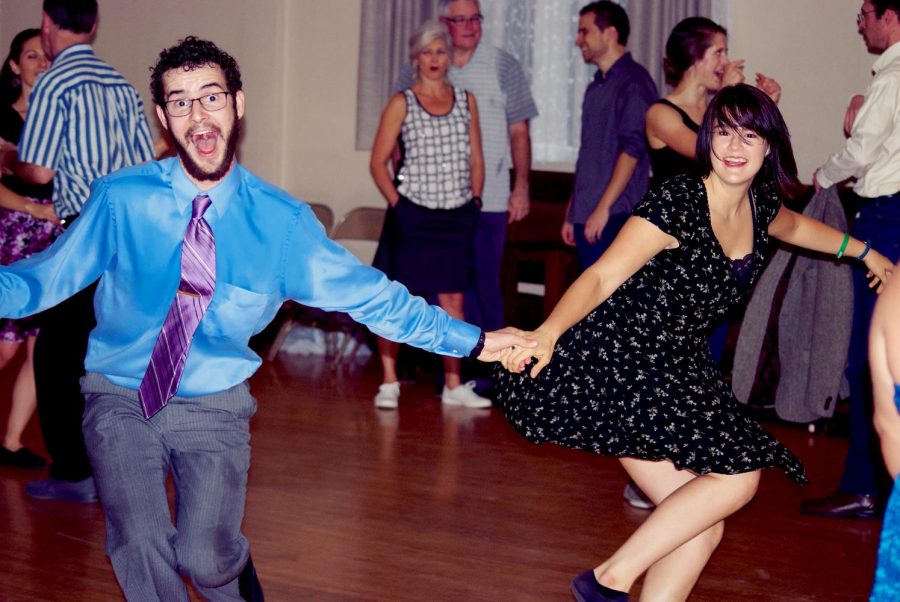Swing club offers dances, classes, workshops
Community dance group welcomes amateurs, seasoned
The Swing Devils of the Palouse, Inc. members dance to a variety of classic styles. They start beginners off with East Coast Swing, which has more of a bouncy movement.
October 13, 2017
Dances from the 1920s to 1940s come alive again through the swing revival scene in Moscow.
The Swing Devils of the Palouse, Inc. followed the trends of the late 1980s and early 1990s in the revival of swing dance, club member Alex Boughamer said. Established in 1998, the club wanted to take advantage of the popularity of new bands playing swing in the mid-‘90s.
The Swing Devils welcome all ages, Boughamer said, from high school and college students to their professors. Their no-smoking and no-alcohol policy makes for a nice environment for everyone, he said.
The club began hosting dances at the Moscow Moose Lodge last year, after CJ’s Nightclub closed. Some of the club members also became members of the lodge, Boughamer said, to facilitate good relations between them.
“Now we have social media, but back then we had social interaction,” Boughamer said. “I think [social interaction] is more personable with not only verbal, but nonverbal communication [in dance] as well.”
Beginners learn the East Coast swing first because of how fun and bouncy it is, said Stacie Anderson, former board of directors member. Then they will move on to Lindy hop once they learn the basics.
The Swing Devils give beginner lessons every Thursday starting at 8 p.m. From 9 – 11 p.m., they have their social dance with a DJ, Anderson said.
The club also hosts dances on the second Friday of every month at the Daily Grind in downtown Pullman, for people who can’t get to Moscow but still want to dance.
The board coordinates all the events, such as workshops and dance nights, Anderson said. Last weekend, they hosted a Lindy hop and jazz workshop. They often carpool to the swing scene in Spokane.
A “scene” is a large, organized group of dancers who meet in a set area. There are a number of vintage swing scenes in Spokane, but no clubs.
“It definitely changed my life for the better,” Anderson said. “My coordination is so much better and I gained so many friends. You have a network of people going to a different city, you automatically have friends there.”
Every year, the Swing Devils host their “Swing Out Nowhere” weekend workshop, which teaches a number of different styles of swing, including Lindy hop, East Coast swing and Balboa, Anderson said.
The swing genre encompasses a variety of different dance styles, Boughamer said. Dances from the 1890s to 1920s considered swing, such as the cakewalk or Texas Tommy, are the original swing dances that influenced later ones.
In the 1920s, the Charleston became one of the most popular forms of swing, and had the ragtime style music that most people associate with swing, Boughamer said. It later evolved into breakaway and then Lindy hop.
“Legend has it, a reporter from downtown Manhattan went to Boston to report on this new dance craze,” Boughamer said. “‘Shorty’ George Snowden, one of the creators of the dance, looked over at the day’s newspaper and said ‘we’re doing the Lindy hop.’ The newspaper headline read ‘Lindbergh hopped the Atlantic Ocean.’”
The Lindy hop is many people’s favorite dance, he said. Not only do people dance with a partner, but they can also do moves independently while dancing with said partner, which not many dances even today allow.
Balboa started in California as a very unusual dance, Boughamer said. People can dance extremely fast, but not get tired. It normally has small footwork, but some break away to a bigger step swing.
“Balboa has a very bizarre lead,” Boughamer said. “You lead with your torso like an Argentine tango, in which your bodies are connected most of the time.”
Swing Devils of the Palouse dances take place at 8 p.m. every Thursday at Moscow Moose Lodge, and at 8 p.m. on the second Friday of every month at the Daily Grind. Admission to Thursday dances is $5 and Friday is by donation. Fees will be waived if a copy of this article is brought in.








